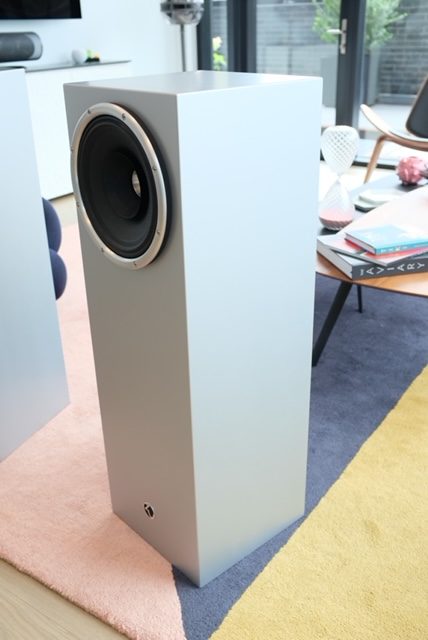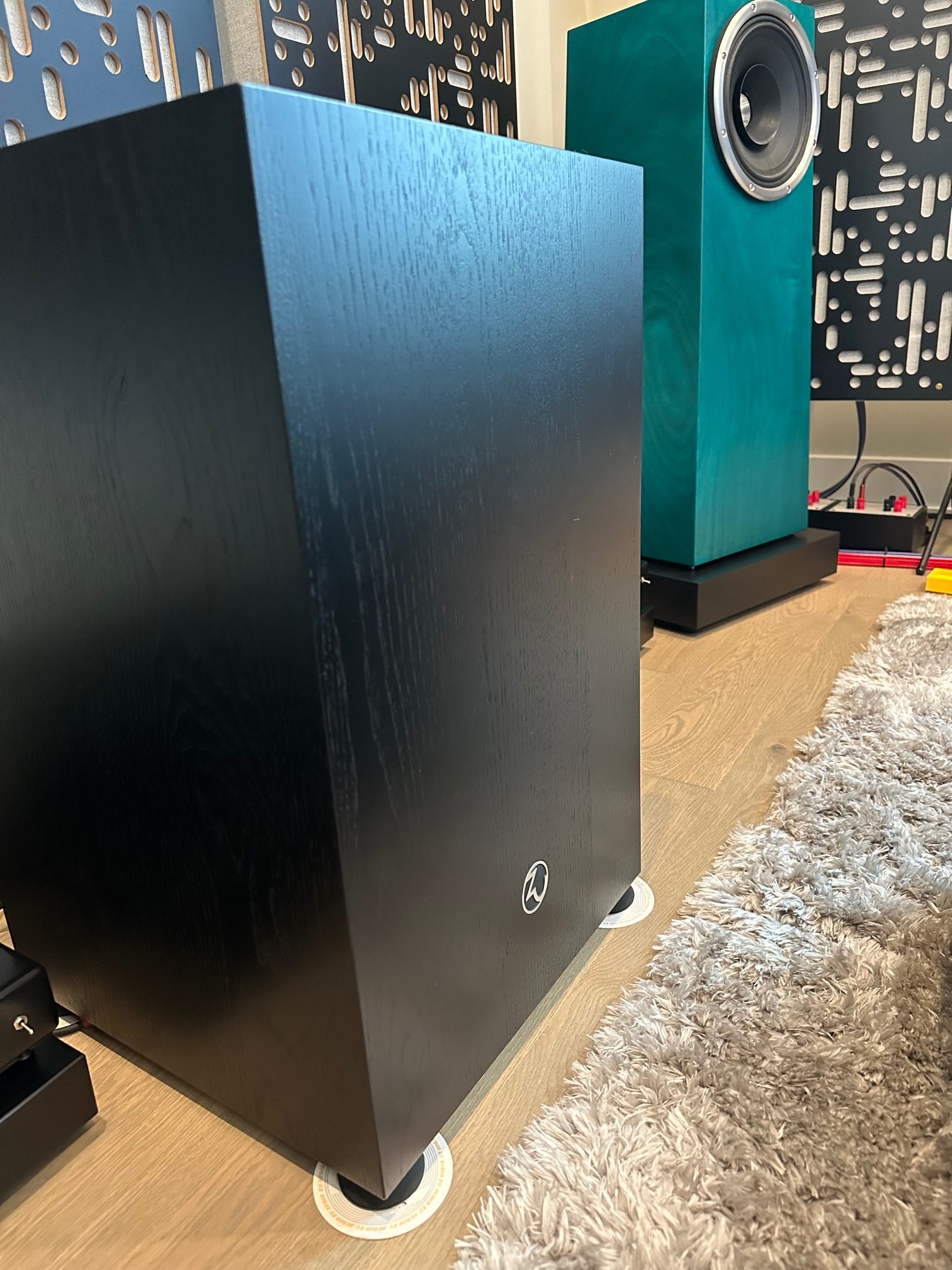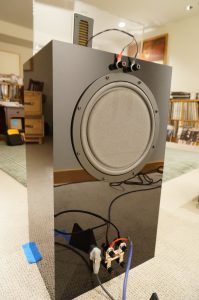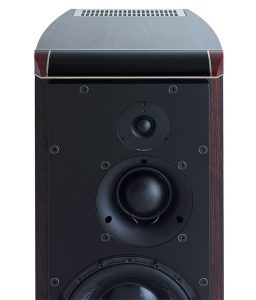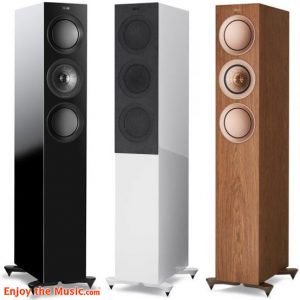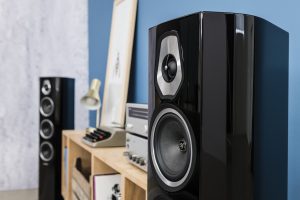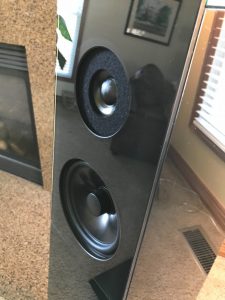Zu really impressed me this year. I have listened to their speakers in the past but, when I heard the Soul VI in my room I fell in love. So much so, that I bought them immediately after I completed my review. When I was working on that review, Phil, Zu's business advisor, told me that the Soul VI was just the beginning, and that they had several other updates planned to their speaker line. One of those updates is the subject of this review, the Union 6. When Phil sent me an email asking me if I wanted to check out the Union 6, I responded absolutely.
The Union 6 is a three-way marriage of the new technology that debuted in the Soul VI, the cabinet shape and price profile of the old Omens, and the newly updated Zu-Griewe scheme (which we will talk about a little later in the review). Starting at $2899 the Union 6 represents Zu's new, readily available entry-level speaker. What I will tell you is that the marketing claim is true, these sound anything but entry-level and can, truly, be your last speaker purchase. Let's dive in.
Receiving and Unboxing the Zu Union 6
The Union 6 speakers arrived individually boxed, and like all Zu speakers, they were quite heavy. They were heavier and physically larger then the Soul VI. Some of the weight is due to the material difference. The Soul VI is made of Okoume, which is a light weight, highly damped rigid hard wood. This allows the cabinet to be lighter then the Union 6, which is made from MDF. Of course, as I unboxed the speakers I would have had no idea that MDF was the material of choice.
Zu shipped me a pair of Union 6 speakers in Mercury, a finish that adds $800 to the price, and is well worth the extra cost if you want to make a statement. I have never seen a solid color finish that looked like this from a speaker manufacturer before. It honestly looked like I was staring at a car. It had the sparkle and uniformity of an automotive finish. To be clear I am not saying that this level of finish quality is unique to Zu, I have seen Focal speakers that look as good. However, with this finish, the Zu is a $3699 product, where the Focal is three to five times more expensive. It is really incredible how beautiful these speakers are.
The style of the Zu Unions is very unique, it will either excite you or it won't. They are rectangular obelisks that have a footprint of approximately 12" x 12". They are shockingly somehow both small and tall at the same time. The front of the speaker is dominated by Zu's 10-inch driver, and the UAPT50-3 super tweeter mounted in the center of the driver. What is exciting is that this is the same main driver that is used in both the Union 6 Supreme and the Soul VI. However Zu did change out the super tweeter to accommodate the lower price target.
Turning the speaker around, you will see the familiar binding posts, as well as Zu's B3 Speakon connector, which is an awesome socket and plug combination for use with Zu speaker cables. It is my personal opinion that all companies should move from binding posts to Speakon, but that is rant for another day. The other thing that is a first for newer Zu speakers is that the Griewe exit is on the lower back rather than facing the floor.
That Griewe exit is a slot on the lower back panel that might look like a port, but isn't. Most Zu speakers have interfaced with the room using the Zu-Griewe room-adaptive acoustic impedance scheme that until now had a floor-facing exit, requiring users to find the optimal floor gap by adjusting the height of the feet of the speaker. The goal was to find the best balance of tone, bass response, bass quality, and projection for your room within a gap window of ¼" to 1-1/2", most commonly in the 3/8" to ¾" range. Adjustments to this gap and getting this gap right were critical to getting great sound out of my Soul VI. The entire point of adjusting the gap is to acoustically couple the speaker to the room and allow the speaker to see the room. Setting the gap correctly results in smooth, deep, and punchy bass, a great mid-range, and clean highs. Setting the gap incorrectly can result in a bloated bass or treble-heavy sound depending on how it is set. Zu has an excellent write up explaining the Zu-Griewe technology and how to set the gap.
However, what is really exciting about the Union 6, thanks to to the improvements to the Zu-Griewe technology, which comprised of additional internal wave management developed by Rick Henthorne with Sean Casey, is that users no longer need to set a gap, you do not even need to worry about wall distance (as long as it's over 2 inches). The Union 6's new rear acoustic interface is not sensitive to distance. I tested this out moving the speaker both closer and further from my walls, and while like any acoustic device you will have changes as a speaker approaches and moves away from a wall, the usual signs of ports being too far or too close to wall never showed up. What was true though is that the tonal and acoustic properties of the speakers stayed consistent. Comparing that to the 1/8th inch sensitivity that the Soul VI had during my adjustments and all I can say is, "man I wish they did this for the Soul VI." The rear exit is also a feature of Union 6 Supreme and the imminent Definition 6.
The Union 6 is an 8 ohm load, and it is an incredibly stable 8 ohm load. It is also 99dB/watt /m efficient. What this means is that nearly anything can power these speakers, be it a 2-watt single-ended tube amplifier, or 250-watt solid-state amplifier. We will talk more about this later, but the biggest thing to remember is with all that efficiency comes the need to control noise as it moves through your gear. While this was not an issue in my setups, I have heard setups that have higher resting noise, and the Zus will tell you if you have this problem.
The Union 6 is more similar to single driver speakers then a traditional 3-way crossover transducer. It employs a single driver and a super tweeter. Zu calls the tweeter a super tweeter because they do not roll the tweeter in until about 12,000Hz. The single 10-inch driver handles all other sound reproduction. This means that the human voice and most instruments are reproduced just using the 10-inch driver with its whizzer cone, which results in an incredibly coherent and accurately timed sound, that is crossoverless and therefore free from crossover distortion.
This is a reason I really like Zu speakers, the cohesion that the single driver offers is incredible, and where I find traditional and true single driver systems leave you wanting at the top end, Zu's super tweeter has you fully covered. This design is not without compromise; however, I think the trade offs are well worth it and everyone who has heard my Zu's has agreed.
Break In and Initial Thoughts
Zu breaks in every speaker at their factory in Utah before shipping, however, I find Zu speakers benefit from additional break in time. For example, my Soul VI, which are used nearly every day, benefit from 10 hours of break in if they go a few weeks without me listening to them. The changes in my case are much smaller than when you first get the speaker, but saying it a different way, Zu speakers like to be played.
With the above in mind, I let the Union 6 break in as my primary 2-channel home theater speaker for the first three weeks. During that time, it was clear that they shared more similarities with my Soul VI, than differences. The tonal presentation is very similar, with the Union 6 being a bit less refined. While the Union 6 and Soul VI share the same main driver and the same load characteristics, I found the Union 6 to feel slightly slower, and even though they have similar efficiency, I found them to feel slightly less explosive. I believe what I am hearing is the inherent differences between the MDF material used in the Union 6 and the Okoume material used in the Soul VI. To be clear, without this direct comparison, I would have never noticed this difference, but given that the Soul VI was sitting in the other room it was just too easy for me to figure it out.
Over the break in period the Union 6 became a little less bright, and a bit smoother in the mid-range. The bass profile, also filled in, but retained its super fast characteristics.
Review System
Home Theater
- NAD M17 V2
- Emotiva XPA-1L Mono-blocks
- Furman Power Conditioner
- Blue Jean Cabling
Listening Room
- DCS Rossini
- ampsandsound Zion Mono-blocks
- PS Audio P12
- Wireworld and Wywires Cabling
Starting out in the Home Theater
Given the retail price of the Union 6, I wanted to review it in an imperfect, untreated space with gear that is nice, but will not ultimately break the bank. Once the break in period was over I sat down and started with some music.
Traditionally my home theater does not stage very well. Movies sound great, but music has always sounded pretty flat. I always believed this was because I have two walls of glass in this room. All the reflections would simply muddy the stage.
To my surprise, as I put on the latest Red Hot Chili Peppers song "Black Summer," I began to see the stage come alive in front of me. Similarly, I noticed instruments extending past the edge of the speakers. To say I was impressed would be a bit of an understatement. The other thing I found interesting was that my wife, who at the time was in our kitchen, commented on how good the system sounded. For context our living room and kitchen are one giant rectangle, with the home theater/TV area on the far end of the rectangle, and the kitchen on the close end of the rectangle. When you stand in the kitchen you are perpendicular to the speakers.
When I walked over into the kitchen, I noticed that the staging was gone but the tonal properties and details still remained. Zu really has done a great job of achieving point source like performance out of their drivers. The only speaker I have heard with a similar off axis profile is the KEF LS50 Wireless II, but hearing it from a passive loudspeaker is something else.
Watching TV with this speaker was a pure joy, whether it was an episode of First Man, which on my old system has some passages that were hard to make out the dialog in, or a re-run of How I Met your Mother, the Union 6 really delivered. Similarly, with the Union 6 in the living room we played more music than we had in a long time in that space. Listening to Snarky Puppies was a joy, while the staging was not perfect due to the space, the separation and tonality was spot on.
Now some audiophiles who read this review might have read the review system section and asked, why does this guy have Emotiva XPA-1Ls? The answer is because they are exceptional amplifiers, and they have a very special feature. With a flip of a switch they bias themselves 30-watts into class A bliss. This means that as long as I do not exceed 30 watts of output power the amplifier is a solid-state class A amplifier. Listening to the Union 6 in class A mode was a true joy. It also showed their ability to be transparent. Enabling class A mode on my XPA-1Ls provided a softer touch. Any hard edges in the treble softened and the resulting performance on the top end was as perfect as one could ask for. The mid range expanded and became warmer, and the bass loosened slightly, but retained its composure.
Queuing up one of my favorite albums, St Vincent's Masseducation, the guitar ripped through the air, her voice retained all of the tonal properties I expected of the Zus, and it felt like I could turn the the volume level to infinity. My ears were going to bleed before these speakers compressed, and I was not risking my hearing to find out when that could happen.
For the entire time the Zu was in my home theater, the home theater was in a 2.0 configuration. I did not miss my traditional 5.1 system, but I was curious if when I put on a movie that would change, especially in the bass region. To find that out I queued up one of my favorite films Argo. The opening scene where the Iranians storm the embassy is a great test of a home theater. There is so much detail in the chaos. It can also sound incredibly shrill with the wrong speakers, and it can sound like noise with poor processing or amplification. As the crowd chanted I felt them surround me in the space. I felt the energy swell into the room. I suddenly felt the thumping in the air as the helicopter flew over the crowd, again and again the noise of the blade hit me as the chaos of the crowd grew. Every word was clear if you focused on it, vocals centered themselves appropriately, and dynamics were exceptional.
The Zu Union 6 were the first speakers to make me consider dismantling my surround sound system for a two-channel system. They proved to me that two speakers can do what five do if system design and synergy are done with care. In a mixed use space, I fully recommend these speakers, they can pull home theater duty even though you don't have five of them. While it would be overkill, I would love to build a 5-channel system with 5 Union 6s, I bet it would be incredible.
One thing I want to call out is the bass response. I found the bass response excellent for a tower speaker of this size, in my space I found they started to drop just as they crossed below 40hz. This is not the fault of the speaker, but instead the fault of my room, as every speaker I have ever put in that room has the same issue. If you do consider these for a 2-channel home theater setup, I would start with just them to see how they perform, but I would mentally align yourself to buying a sub for that last octave of bass. Zu of course makes an excellent sub with the Undertone, and I would imagine the KEF K62 and SVS Micro 3000 would work well as well if you want something a little less expensive. To be clear I was not wanting for a sub with music, however, films like Battleship (an entertaining movie and serious demonstration of what a subwoofer can do) left me wanting a little more.
Listening to the Union 6 in my Listening Room
I am very fortunate to have the space, a wife who allows me to have a dedicated listening room, and be able to spend the money I have spent on this hobby. As a result, my listening room contains equipment that one would not match with the Union 6 traditionally. Similarly, a person buying the Union 6 probably would not put it into an acoustically treated space. Heck the speaker cables in the room sadly cost more then the Union 6. All that being said the question is, can the Union 6 scale? The Soul VI, which is a little over twice the price of the Union 6 scaled with the components in my listening room so well that I was convinced that I was listening to $20k speakers. A friend of mine assumed the Soul VI were $60k speakers, Zu's price to performance ratio is crazy, and I wanted to understand if the Union 6 could really be "your last speaker."
After moving my Soul VIs out, I placed the Union 6 into the space and got things connected, I ran a few measurements with REW to make sure things looked okay, and made a few more minor adjustments. I then pressed play…these did not sound like the same speakers that I had just pulled out of my living room.
The first thing I noticed was that the staging dramatically increased. While again the Soul VI was a clear winner in depth and width, the Union 6 was now delivering 80% of the performance of the Soul VI. The Union 6 also was outputting more bass in this space, and this is the one area where it managed to outperform the Soul VI, delivering another 5hz of usable bass to get it down to 33Hz before drop off in my space which was really impressive.
While the Emotiva XPA-1L is an excellent amplifier, the ampsandsound Zions are the best amplifier I have ever heard, period, end of story, irrelevant of price. It is fast, smooth, detailed, a little warm, and never thick, it creates a strong musical foundation and constantly builds on top of that foundation rarely if ever compressing.
The Union 6, powered by the DCS and Zion combo came alive with detail, warmth, and space. The super tweeter kept things spicy, and cymbals sounded as real as they did on the Soul VI. Every note had weight behind, and every instrument felt like it was in the room. Dynamics were good in comparison to the Soul VI, and without that comparison, they were excellent.
On its own the Union 6 was exceptional, it was transparent, and showed off a lot of what my system was capable of doing. Would I personally marry the Union 6 with ~$50k in front end components? No I wouldn't, but remember I did do that with the Soul VI. What the Soul VI brought to the table was refinement. Finer details were easier to hear with the Soul VI, really complex passages, like on "Mira" on Melody Gardot's Live in Europe album felt bigger, and instruments had better isolation through the Soul VI then the Union 6. The thing to remember though is the Soul VI is over twice the Union 6 base price. The Union 6 consistently delivered more then 80% of the performance of the Soul VI in my listening room. It not only sounded great with my expensive equipment but it was still transparent enough to show off what that equipment was doing.
For example, the DCS Rossini has a ton of settings that change how it processes the digital file before converting it to analog. I will be honest, some of those settings are really hard to tell the difference between. Only a few speakers have been able to allow me to hear the difference clearly. The Union 6 is one of those speakers. They really are that transparent, but they are also forgiving. The Soul VI sounded great on my home theater system, but it was edgier, and less enjoyable on that system then it is in my listening room. The Union 6 on the other hand was enjoyable in both spaces.
Different Amplification, don't worry the Union 6 got you
During my time with the Union 6 I powered it with high wattage solid state amplifiers, 35-watt tube push pulls, and an 8 watt single ended 300B amplifier. At no point did I ever think, man this is a bad pairing. Instead each amplifier brought its own flavor. The 300B was honestly probably my favorite paring, it was warm, fun, and still sounded very controlled.
Similarly, running the Union 6 off of a 30-watt class A solid state amplifier was incredibly enjoyable. The extra warmth and the softness really allowed the Union 6 to show off what it was capable of, which is toe tapping fun and rich tone. While more power helped at higher volume, I have no concerns with running the Union 6 off of low powered amplifiers, and honestly I think it is one of the better speakers for that task.
Concluding Thoughts
I didn't know you could buy such a great sounding speaker at this price. I didn't know a speaker at this price could scale into systems that are literally 10x-15x their price. The thing I think we need to remove is the term "at this price." The Union 6 is an exceptional speaker at pretty much any price. Zu makes more expensive speakers, and they are better, but the Union 6 could easily be someone's first and last speaker. They retain everything that I love about my Soul VIs in a more affordable package, and provide 80% of the performance in nearly every criteria. I wish more companies would build entry level products like Zu does. The Union 6 has my highest recommendation, and is easily the best passive speaker I have heard under $3000. It will scale easily into $15k or $20K systems, and sounds great with a modern well designed $2000 integrated.
Sean, Phil, and the entire Zu team, you dazzled me with the Soul VI, you wowed me with the Union 6, I am terrified to know what is coming next. Thank you for allowing me to review the Union 6.
Union 6
Retail: $2899 a pair
Zu Audio






